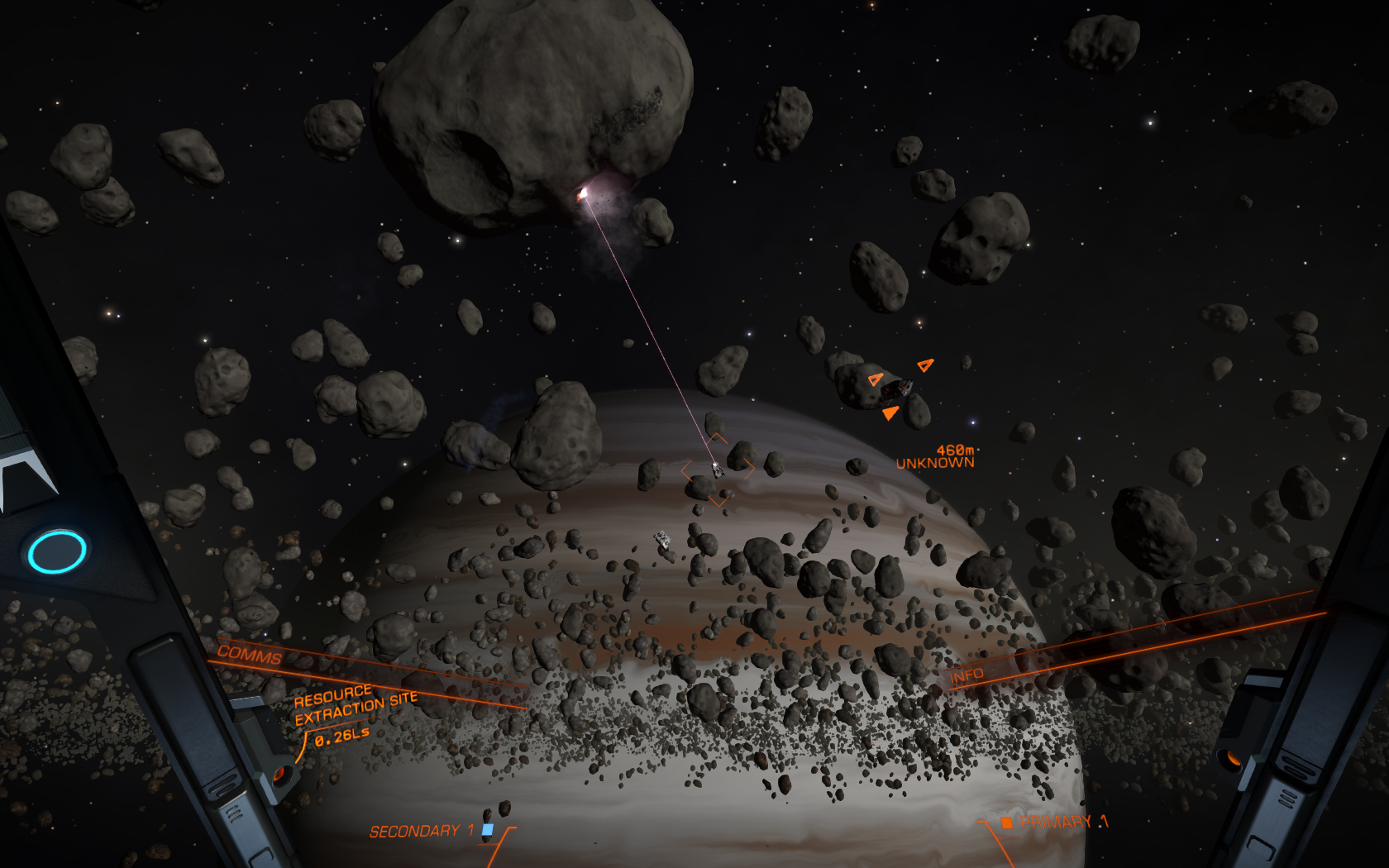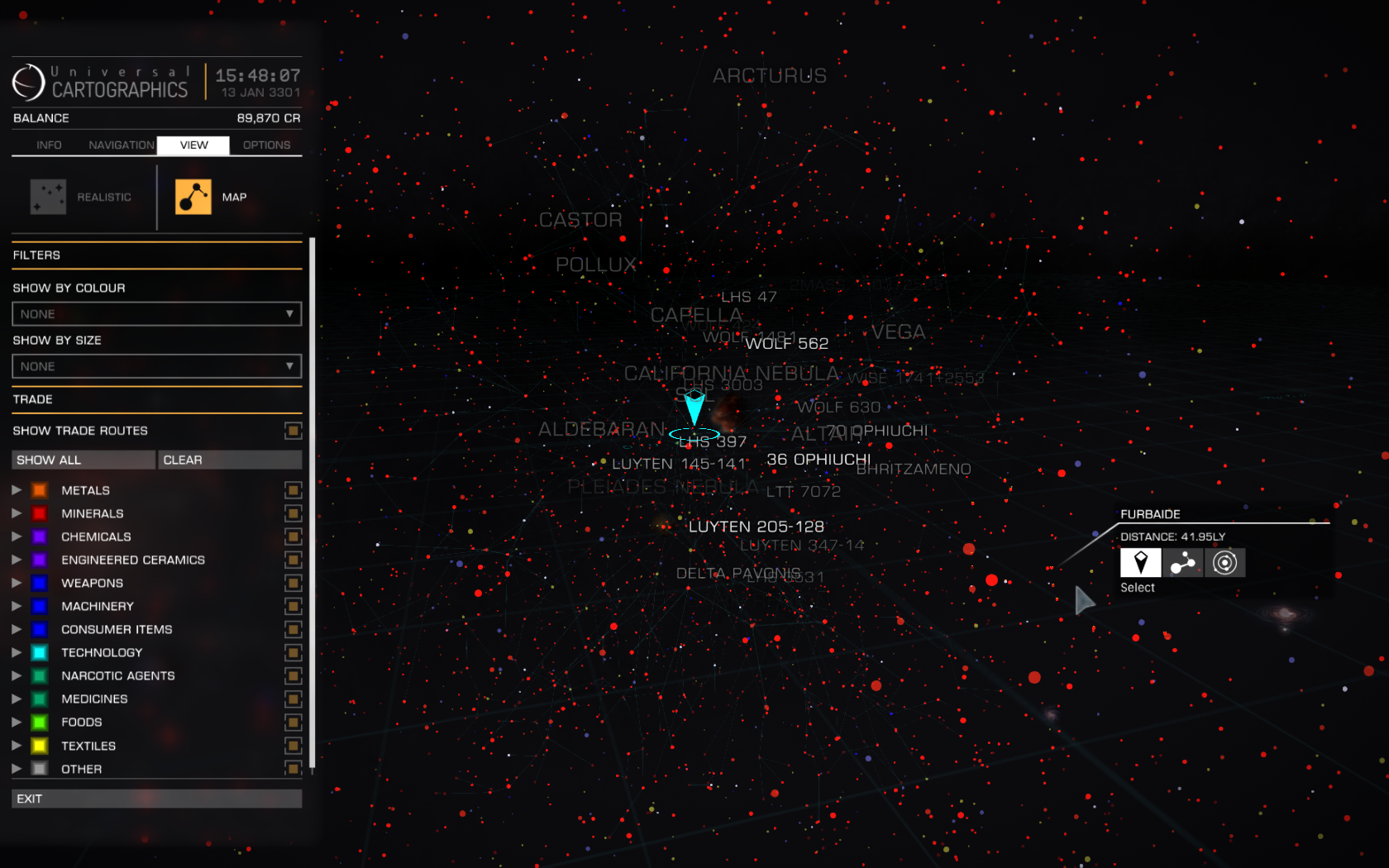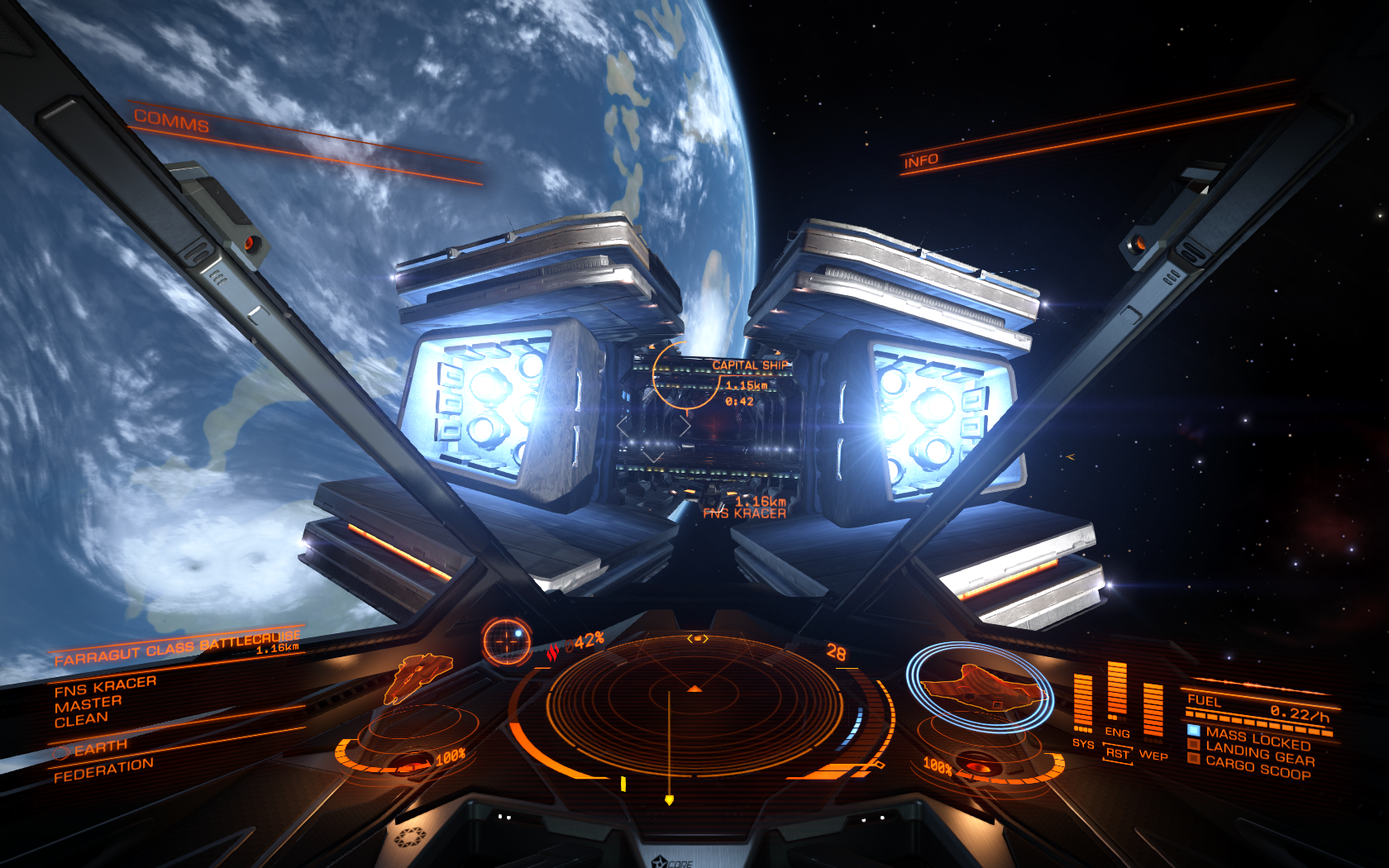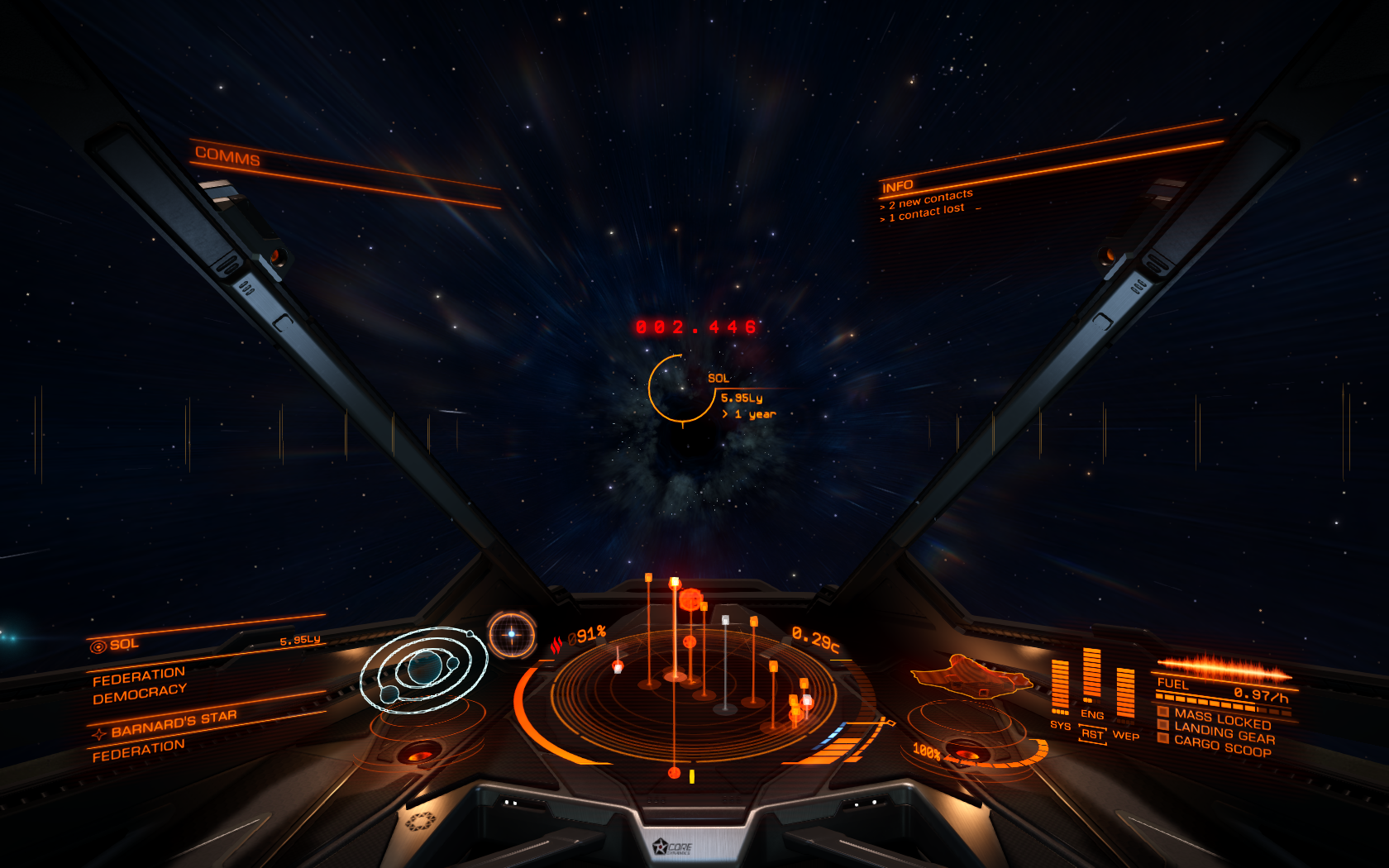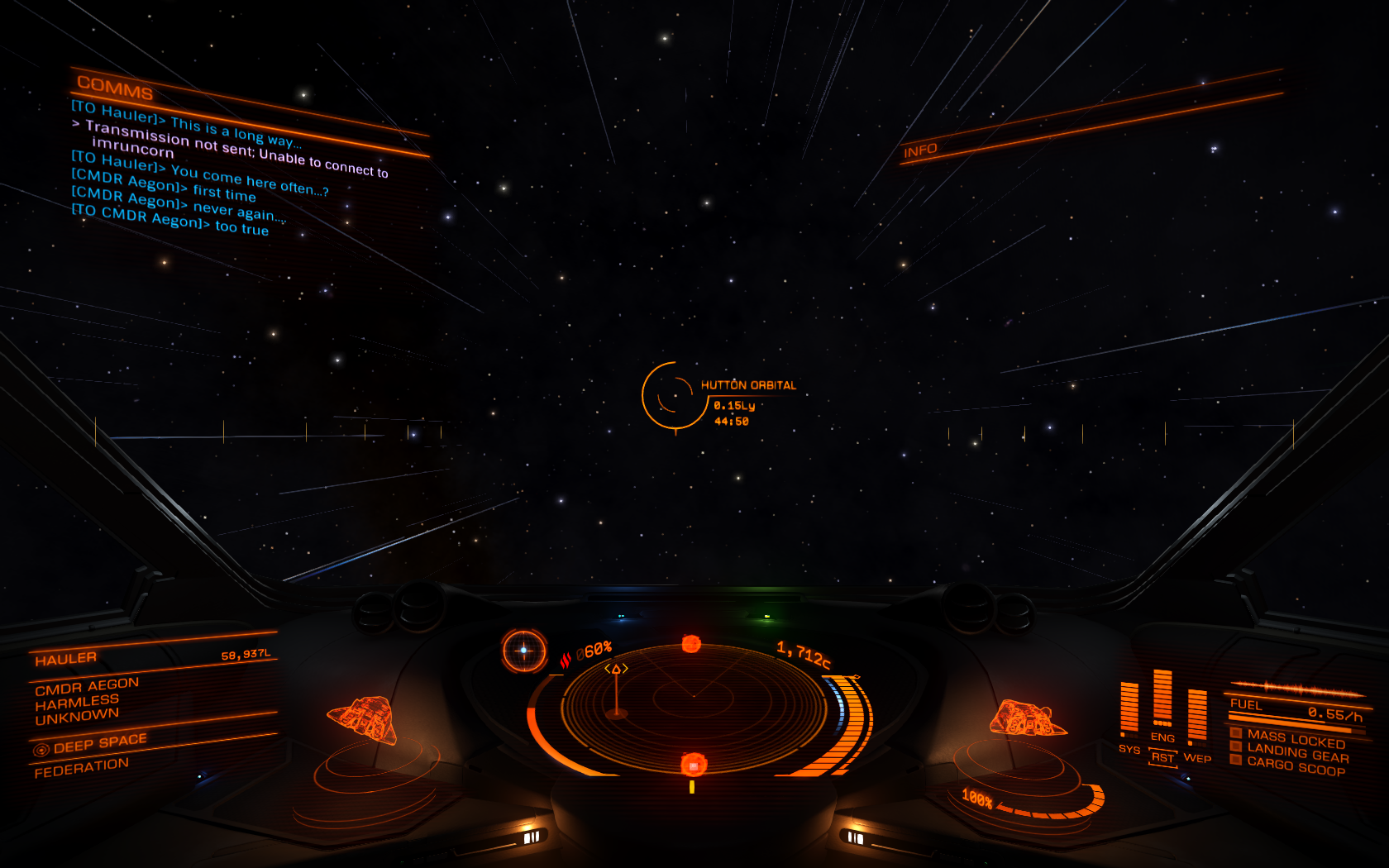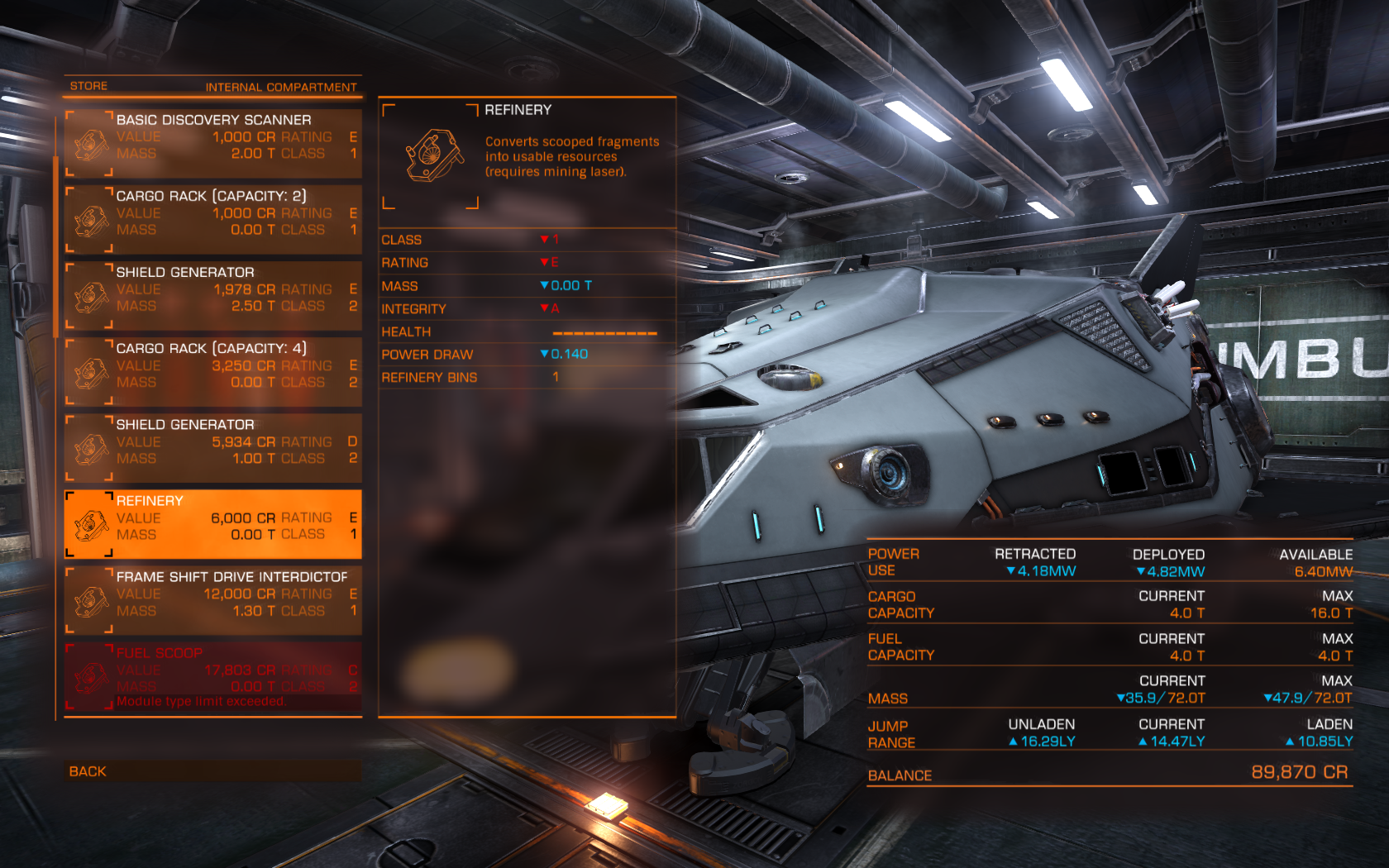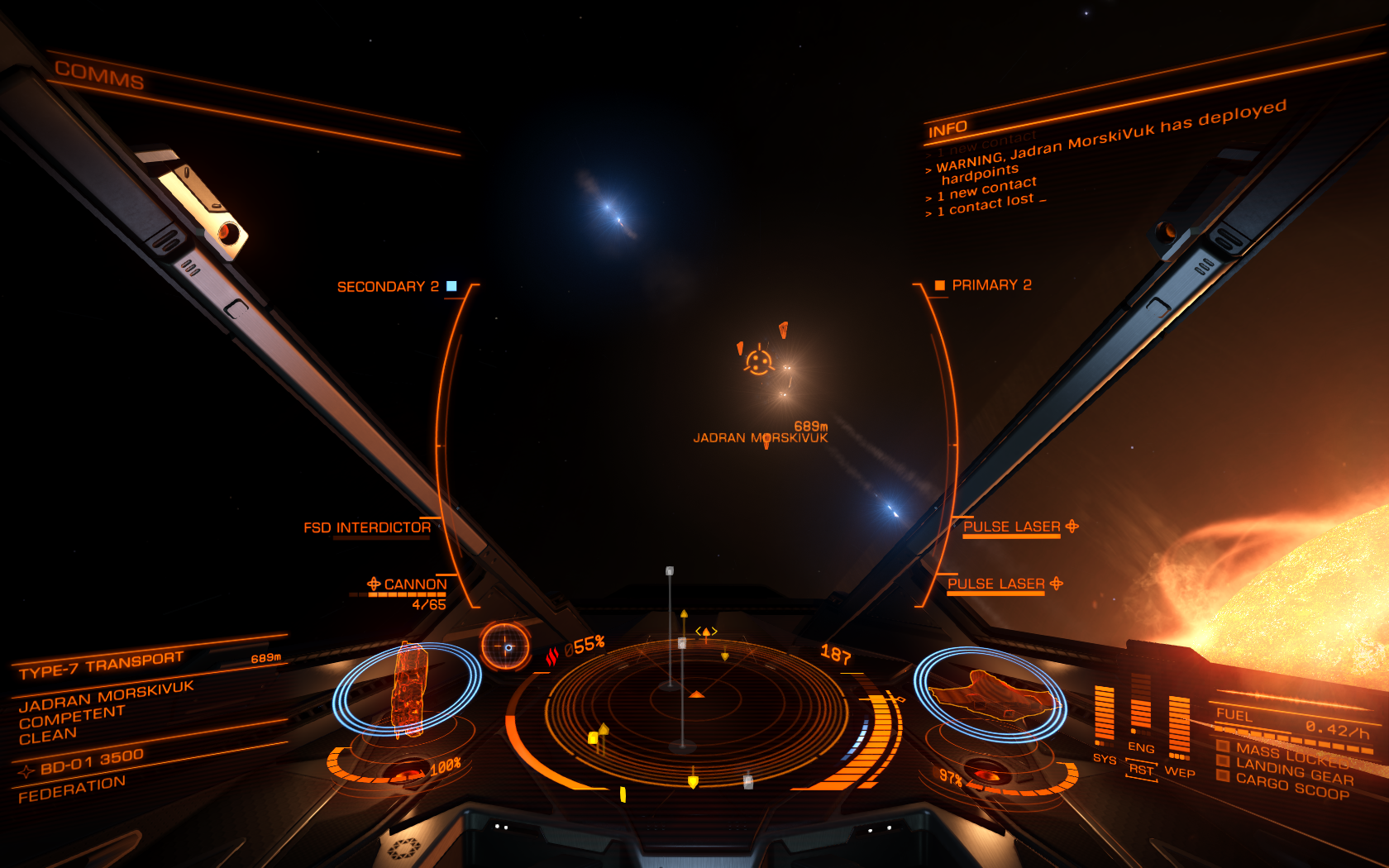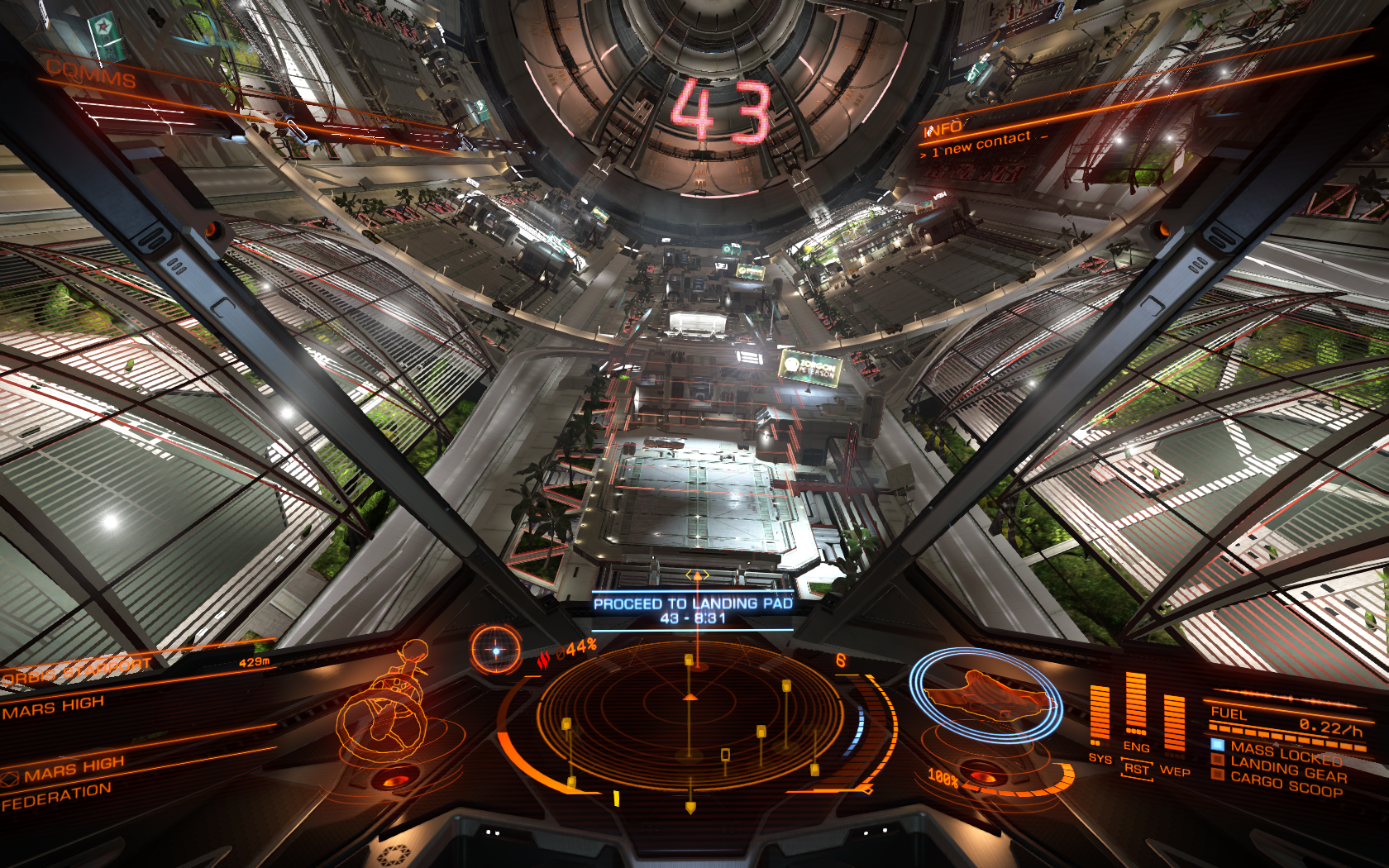Check out our Reviews Vault for past game reviews.
I’ve been dreaming of galaxy maps lately. Interplanetary routes spanning hundreds of light years have spread their way across my sleeping mind, with multicolored trading routes shooting off into infinity.
Elite: Dangerous is to blame. You see, it’s become something of an obsession. Sitting watching my daughter’s soccer training on a rainy Wednesday night, my mind drifted off to the bounties on offer in LTT 7448 and the best trade routes for gold and palladium near Sol. I just couldn’t shake the space sim from my head.
I left it running for nearly 7 days straight last week, dropping in to grab the throttle of my Eagle and run a mission, and then standing up again six hours later, wondering where the time went. At times, my sleeping mind struggled to separate the game from reality, and I’d wake in the night not knowing where I was.
It’s funny really, because life in Elite: Dangerous — released by Frontier Developments for PC on Dec. 16 — isn’t always that exciting. In fact, space travel can often be dull. But it’s the little moments of wonder, like stumbling on a funeral procession in deep space or dropping out of supercruise to find a small crew of Sidewinders quietly mining the asteroid belts around Jupiter, that make it such an engaging, immersive, and addictive experience.
What You’ll like
A vast galaxy to explore
Thirty years ago, the first Elite offered a 2,048-planet universe that let you play how you want. This new version takes the concept to its logical conclusion, giving you the chance to visit every star you can see in the night sky.
With 400 billion star systems to explore in a full-scale re-creation of our own Milky Way — part mapped and part procedurally generated — it has almost no end to the distance you can travel. And the open-ended nature of Elite: Dangerous means that embarking on a career in space piracy is as viable as setting up a trading company, becoming a bounty hunter, or simply heading out into the darkness and exploring uncharted stars.
Examining Elite: Dangerous’ galaxy map is initially daunting, especially when you realize it stretches out in all directions, but you can’t deny the scope for exploration and adventure this massive open-world offers. Concentrating on a smaller area of play for your first dozen hours helps control the mild panic you may experience when you pan around the full galaxy map, taking in the size of it all.
While not all the systems you visit are spectacularly exciting — some are simply a sun surrounded by deep space — you always have a chance of spotting the glimmering surface of a deep blue water-world, or discovering a forbidding far-off space station playing host to pirates.
You really can play how you want
Elite: Dangerous isn’t a predefined experience. If you’re looking for a 20 hour story that’ll funnel you to a neat ending, you’re in the wrong place.
Instead, it sets up a galaxy-sized playground to use how you want. So far, I’ve spent time hunting bounties, invested in a Hauler and trucked tea and valuable metals between star systems, and even turned my hand to mining asteroids, meticulously refining the raw materials they release for profit.
However you choose to play, you’ll want to earn credits to beef up your existing ship or expand your shipyard. With a variety of craft to buy with in-game currency and the freedom to customize them with a huge range of weapons and gadgets, Elite: Dangerous encourages experimentation, especially with the lack of hand-holding it provides.
It also has missions that you can carry out, and though they reward you with credits and respect, these are by no means obligatory. Taking them on can prove profitable, though, particularly early on.
Its universe also has an overarching power battle between three major factions — the Empire, the Federation, and the Alliance — that’s told through events, missions, and news feeds both as you play and via the Galnet website. Elite: Dangerous promises that you can influence these power battles in what is a persistent universe, but it’s too early in its life to see how this will really play out.
You’re not alone
You can play Elite: Dangerous by yourself, only encountering A.I. commanders, but it comes alive when you head into the multiplayer open play.
You’ll find that some systems are packed with other human players — particularly those within easy reach of the starting system — while other, more distant parts of space are relatively uninhabited. Wherever you end up, though, the reality of sharing space is pretty darn cool. You can use text chat with any players within range and open voice comms, too — with an in-built voice filter giving a great sci-fi movie feel to your chat.
Teaming up with one of my gaming buddies was a real blast as we jumped across stars to meet, then went on a bounty-collecting campaign in a relatively lawless system. Several hours later — with contrasting levels of success — we headed off to refuel, repair, and collect our hard-earned bounties (and for one of us, to pay our fines).
I haven’t teamed up with a larger group yet, but watching a video of a six-player attack on the system authorities in the Ho Hsi system, the possibilities for engaging group play are obvious.
Unfortunately, right now the co-op structure in Elite: Dangerous is kind of loose, with no capability to share mission goals or bounties. Frontier Developments is putting together a free multiplayer Wings update, though, which promises to allow players to form structured groups and work toward common goals.
Complete immersion
I’ve already described how I lost my head in Elite: Dangerous over the past week or so, and it’s really a testament to the immersive nature of the game.
My longest single play session was just over six hours, and even then I had to drag myself away. Whether you’re hunting for pirates, plotting a potentially lucrative trade route, or carrying out a mission bringing much-needed resources to a struggling spaceport, it’s so easy to get sucked into the beautifully realized game world and make “just one more” trip.
Even the smallest moments in Elite: Dangerous can be incredible, and when the game really hots up, it’s almost incomparable. At the tail end of one long bounty-hunting session, I spotted laser fire in the distance and flew over to investigate. Suddenly, I found myself pulled into a battle between two friendly NPC ships and a single, heavily armed Anaconda — the largest ship that players can fly thus far — with a large bounty on its head.
The ensuing fight had me breathless as the three of us played a cat-and-mouse game with the larger ship, swooping in to bring down its shields and deal some damage before heading to a safe distance to recharge our own defences. Fifteen minutes of frantic fighting later, with one NPC ship lost in the heat of battle, we finally took down the Anaconda, and I found myself 80,000 credits to the good — enough money to buy and upgrade a Hauler trading vessel.
It looks incredible
I’m not running the most high-spec gaming PC, but even on my limited rig on the default high settings (not ultra), Elite: Dangerous looks stunning.
Flying over blazing suns and watching the comet trails left by fellow pilots really doesn’t get old, and Elite: Dangerous is full of sights that’ll make you simply stop and stare.
You can take a look at some of these gallery shots to see for yourself.
What you won’t like
Space travel is boring
Space is big. Really big. Elite: Dangerous does a great job of reminding you of that at times, and it’s not always welcome.
The biggest culprit is the Alpha Centauri system, neighbor to Earth’s own Sol. Taking on what looked like a straightforward mission to ship 5 tons of tea, I did a hyperspace jump to Alpha Centauri and locked on to the Hutton Terminal, boosting my supercruise — the fastest way to travel within a star system — to max.
Even flying at around 1,800 times the speed of light, the journey took me 1 hour, 15 minutes to complete. After 10 minutes not getting close, I’d stopped and checked my systems — everything was functioning normally. Then I’d searched the Elite: Dangerous forums and found a 53-page thread warning commanders against the journey.
“Take a packed lunch and a flask of tea if you desperately need to be there,” said one poster, so I did just that. I made a cup of tea (two, actually), stuck on some tunes, and watched the day’s soccer highlights on my laptop while I completed the epic, but largely featureless, journey. The only pleasant surprise when I finally arrived was the chance to buy some Alpha Centauri Gin, which I believe fetches a decent price in certain parts of the galaxy. I just hope nobody steals it before I get the chance to cash in.
While Alpha Centauri is something of an anomaly — I haven’t yet encountered another star system with such a huge distance between destinations — it has other times when you’ll feel the emptiness and vastness of space. And it’s both overwhelming and a little dull.
It’s the Dark Souls of space trading
Elite: Dangerous picks up the mantle held by the role-playing Souls series of being overly hostile and nearly impenetrable for newcomers.
It harks back the early days of gaming as — even with a 107-page digital manual to consult — playing Elite: Dangerous is often a process of trial and error. It has menus in the user interface that you won’t even spot unless someone points them out to you. Even docking caused me no end of problems for the first few hours, before I realized some stations need you to face the correct way for a successful landing.
Unlike most modern games, when playing Elite: Dangerous, I’ve always got a pad of paper and a pen in front of me. It’s to help keep track of where I’m flying, what I’m looking to buy or sell, and where I’ve already been. Nothing in its interface or menus really help you do this; even the galaxy map search requires an exact, correctly spelled and formatted name to register a result.
And as with the Souls games, the clock in Elite: Dangerous just keeps on ticking. The action never pauses if you need to check your systems, and I’ve nearly blazed headlong into a sun fiddling with my ship’s weapons systems.
More frustratingly, any missions you take on are time dependent, and time doesn’t stand still when you log out. Three days in, I came back to Elite: Dangerous to find that I’d upset three factions for failing to complete their missions, and I was now a Federation fugitive for failing to pay a fine on time. It wasn’t the best start to a gaming session, but if you have real-life commitments (as we all really should), you’re going to mess up in Elite: Dangerous.
Pretty early on, you’ll realize that beefing up your ship’s feeble starting equipment is essential, but it’s also something of a stab in the dark. Outfitters offer you all manner of exotic equipment, but where it should fit and how it all works is often unclear. As a result, you kit out your ship and just hope everything will still work when you’re in your next dogfight.
I purchased a shield cell bank that I presumed would automatically improve my shield’s regeneration rate, only to find that it’s an ammo-based item with just two uses. Pretty pointless for me, given my propensity to panic in the heat of battle.
Luckily, if you make a mistake, you can sell equipment back to stores at face value, making it possible to build a decent ship through a process of trial and error.
Always online sucks
It’s a contentious decision to make your game depend on an online connection, but Frontier Developments decided it had to with Elite: Dangerous. The developer planned an offline mode at one point, but concerns about players cheating the system when left unchecked, along with the reality of the amount of work it would take to build, put paid to it.
As it stands, if you’re not connected, you can’t play Elite: Dangerous beyond the few training missions. It’s as simple as that.
What’s more, if your connection to the servers goes down, it’s game over. Over the course of seven days, I lost connection around a dozen times. Most of the time, there was no obvious reason at my end — everything else in my connected (real) world was ticking along quite nicely.
On more than one occasion, my connection dropped at an extremely inopportune time — once I’d beaten a particularly “Wanted” ship down to 5 percent health when I suddenly found myself staring at the game menu.
Hopefully, server improvements will cut these disconnects over time, but as it stands, they’re an annoyance. And I’m going to miss playing Elite: Dangerous on those days when my hokey rural Internet connection’s playing up.
It’s still not finished
Elite: Dangerous was funded partly via Kickstarter, and it’s been through public alpha, beta, and gamma testing periods before launch. But it’s still not finished.
In one way, that’s not great. It has the previously mentioned server disconnects to deal with, the NPC artificial intelligence is sometimes a little unbalanced, and the comms are only working sporadically. It also crashed on me twice in a week, forcing me to manually shut down and reload.
You’ll also find parts that aren’t quite ready to use. I stumbled across some luxuries traders in deep space that I couldn’t actually trade with, and a quick scan of the forums showed that ship-to-ship trading was a beta feature that hasn’t made it back (yet).
The good news is that Frontier Developments still has a large team working on it. In fact, it recently announced that the team has grown to help with continued development, working on both free updates and paid expansions.
In light of this, that “unfinished” tag starts looking more positive, and the ever-evolving nature of the game and its storyline should see further rewards for players who stick around in the Elite universe.
You’ll need a flight stick
OK, so maybe you don’t actually need a flight stick, but playing Elite: Dangerous with a mouse and keyboard or a gamepad just didn’t cut it for me.
To really feel like you’re in command of a ship, you need to have a throttle in one hand and a stick in the other, and that’s an extra expense.
For the record, I played with a Thrustmaster T-Flight Hotas stick, which retails for around $50. It’s at the budget end of the market, but to my mind it’s a solid and perfectly functional piece of hardware.
Conclusion
Elite: Dangerous is unforgiving, obfuscating, and occasionally dull, but it’s always immersive and beautiful. It offers an incredible universe to explore that, despite occasional graphical repetition, offers the tantalising possibility of wonders yet unseen at the end of each new hyperspace jump.
Having played the original BBC B and Acorn Electron versions 30 years ago, this new game has far exceeded my expectations of what a modern-day Elite could look and play like. It offers enough depth to reward tens or even hundreds of hours of gameplay, and you really can play how you want.
Elite: Dangerous has consumed my waking and sleeping thoughts lately, and the promise of what’s to come fills me with hope for future collaborative adventures in deep space. I just hope my internet connection holds up for the journey.
Overall Score: 83/100
Elite: Dangerous is out now for PC. Frontier Developments provided GamesBeat with a downloadable copy of Elite: Dangerous for the purpose of this review.
VentureBeat's mission is to be a digital town square for technical decision-makers to gain knowledge about transformative enterprise technology and transact. Learn More

